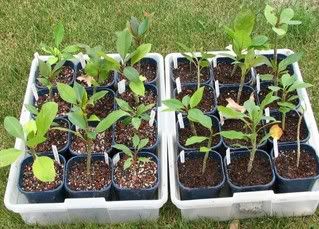TheLorax
Awardless studette
I have two basic cat-free areas in which to grow phrags. The first area has bright indirect light and I have been growing my mottled leaf paphs there and they have been doing very well. The second area is where I have been growing phals and other paphs and I used to grow highland Neps there and they all did well. The area where the mottled leaf paphs grow receives no direct light at all but the ceilings in that room are very high and the walls are painted a semi gloss white and the light bounces around quite a bit from two mirrors over opposing vanities. The second area where I have been growing the others is in the same room but does receive some direct light mid afternoon although it is through windows and screens that we leave up all year round. The light is filtered as if I had shade cloth. The exposure for both is a western exposure.
These are the areas I have without adding supplemental lighting which I want to avoid like the plague.
I took some time to sort out which area I thought my new phrags should go into and which area the phrags that are on their way to me should be sorted into this morning based on comments made by lots of people. So many comments have been made that I'm sort of in a tail spin so thought it best to list out what I have and go from there.
Should mention that all phrags are in about a 1/4" of water.
This is what I came up with so far and I tried my best to avoid phrags which required more light than what I had to offer but may have made mistakes-
P. Cape Sunset- second area
P. Kelly Nash- first area
P. Les Dirouilles- second area
P. longifolium- second area
P. Magdalene Rose 4N x Barbara LeAnn- move from the second area over to the first area
P. Paul Eugene Conroy- first area
P. Sedenii- second area
P. Sorcerer’s Apprentice- second area
P. caudatum- second area (no standing water)
P. pearcei- first area
P. pearcei hybrid- first area
P. schlimii- first area
P. Schroederae- first area
P. wallisii- first area (no standing water)
Just out of curiosity, which area would these be grown in should I ever purchase them in the future-
P. boissierianum- second area
P. equadorense- first area
P. lindenii- second area (knock out, consider trying in a few years)
While I'm at it, what general signs would I look for to clue me in that one of these phrags might be getting too much light? Are there indicators to look for that apply to phrags in general or is this one of those deals where it is going to vary from species to species and hybrid to hybrid? Photos appreciated if possible.
What general signs are there of not enough light?
editing to add more comments to keep everything together for me personally-
Pearcei and many of its hybrids have darker green leaves and the color is not necessarily a sign of too little light.
These are the areas I have without adding supplemental lighting which I want to avoid like the plague.
I took some time to sort out which area I thought my new phrags should go into and which area the phrags that are on their way to me should be sorted into this morning based on comments made by lots of people. So many comments have been made that I'm sort of in a tail spin so thought it best to list out what I have and go from there.
Should mention that all phrags are in about a 1/4" of water.
This is what I came up with so far and I tried my best to avoid phrags which required more light than what I had to offer but may have made mistakes-
P. Cape Sunset- second area
P. Kelly Nash- first area
P. Les Dirouilles- second area
P. longifolium- second area
P. Magdalene Rose 4N x Barbara LeAnn- move from the second area over to the first area
P. Paul Eugene Conroy- first area
P. Sedenii- second area
P. Sorcerer’s Apprentice- second area
P. caudatum- second area (no standing water)
P. pearcei- first area
P. pearcei hybrid- first area
P. schlimii- first area
P. Schroederae- first area
P. wallisii- first area (no standing water)
Just out of curiosity, which area would these be grown in should I ever purchase them in the future-
P. boissierianum- second area
P. equadorense- first area
P. lindenii- second area (knock out, consider trying in a few years)
While I'm at it, what general signs would I look for to clue me in that one of these phrags might be getting too much light? Are there indicators to look for that apply to phrags in general or is this one of those deals where it is going to vary from species to species and hybrid to hybrid? Photos appreciated if possible.
What general signs are there of not enough light?
editing to add more comments to keep everything together for me personally-
Pearcei and many of its hybrids have darker green leaves and the color is not necessarily a sign of too little light.
Last edited:










